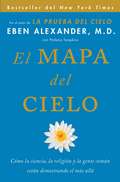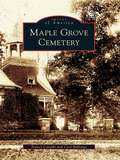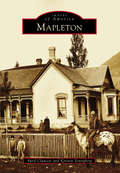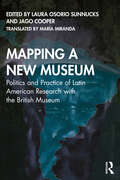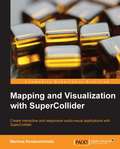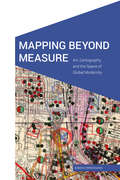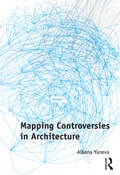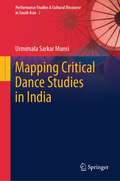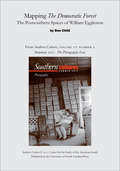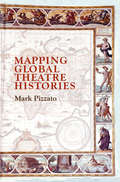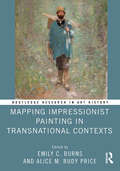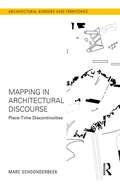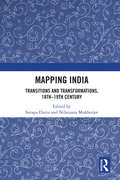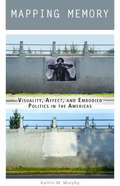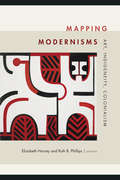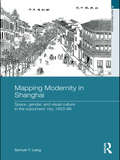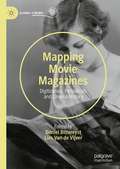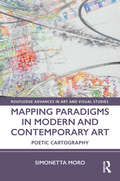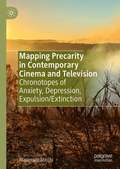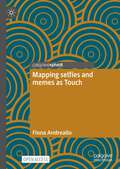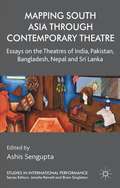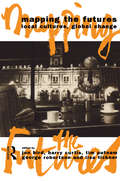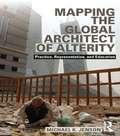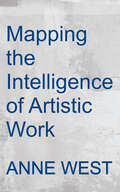- Table View
- List View
El Mapa del cielo: Cómo la ciencia, la religión y la gente común están demostrando el más allá
by Eben AlexanderEl autor de La prueba del cielo, el bestseller #1 del New York Times, recurre a los sabios de tiempos pasados, a los científicos modernos y a historias de gente común para mostrar que el cielo es real.Cuando el Dr. Eben Alexander conto la historia de su experiencia cercana a la muerte y su vivido viaje al otro lado, muchos lectores escribieron para decir que eso resonaba profundamente con ellos. Gracias a estos lectores, el Dr. Alexander comprendió que compartir su historia ha permitido a la gente a redescubrir lo que muchos ya sabían en la antigüedad: que la vida consiste en algo mas que en la vida terrenal. En El mapa del cielo, el Dr. Alexander y su coautor, Ptolemy Tompkins, comparten visiones sobre la vida del mas allá vividas por sus lectores y muestran la manera en que estas se sincronizan frecuentemente con las de los lideres espirituales del mundo, así como con las de filósofos y científicos. Hay un gran acuerdo, a lo largo del tiempo y de las experiencias, sobre la travesía del alma y su supervivencia mas allá de la muerte. En este libro, el Dr. Alexander sostiene que el cielo es un lugar genuino, mostrando como hemos olvidado y como por fin estamos recordando, lo que en realidad somos y cual es nuestro verdadero destino.
Maple Grove Cemetery (Images of America)
by Carl Ballenas Nancy CataldiMaple Grove Cemetery, a rural Victorian cemetery located on the backbone of Long Island," opened in 1875. Found within this tranquil sanctuary are extraordinary monuments with lush landscaping that continues to offer a serene escape from New York City. Beyond its gates are the resting places of those who left their mark on the world. Maple Grove Cemetery features the fascinating stories of such noteworthy individuals as Millie Tunnell, former 111-year-old slave; Ann Wilkins, one of the first female missionaries to Africa; John Sutphin, Queens politician and philanthropist; Samuel Loyd, America's puzzle king; Charles Manly, aviation pioneer; Alfred Grebe, radio and broadcast pioneer; Elisabeth Riis, wife of social reformer Jacob Riis; Russian pianists Josef and Rosina Lhevinne; and Blues singer Jimmy Rushing. The cemetery was placed on the National Register of Historic Places in 2004."
Mapleton
by April Clawson Kjirstin YoungbergLocated south of Provo and artistic Springville, Mapleton was named in 1901 for its abundance of colorful maple trees. For centuries, American Indian tribes had regarded the bench overlooking Hobble Creek and the valley below as sacred ground and gathered there annually. Catholic explorers hiking down Spanish Fork Canyon, nestled beneath a majestic mountain, first mapped the area in 1776. These Spaniards named the peak Sierra Bonita, though nearly everyone today calls it Maple Mountain. By 1850, Mormon pioneers had settled in Springville, using the rich earth between the creek and the river as farmland. Little by little, they built homes and stayed. The continued perseverance of this community to maintain its country charm is evident throughout the city. Conservation of the foothills and open spaces is an ongoing concern to residents.
Mapping a New Museum: Politics and Practice of Latin American Research with the British Museum
by Laura Osorio Sunnucks Jago Cooper María MirandaMapping a New Museum seeks to rethink the museum’s role in today’s politically conscious world. Presenting a selection of innovative projects that have taken place in Latin America over the last year, the book begins to map out possibilities for the future of the global museum. The projects featured within the pages of this book were all supported by The Santo Domingo Centre of Excellence for Latin American Research (SDCELAR) at the British Museum (BM), with the aim of making the BM’s Latin American collections meaningful to communities in the region and others worldwide. These projects illustrate how communities manage cultural heritage and, taken together, they suggest that there is also no all-encompassing counter-narrative that can be used to "decolonise" museums. Reflecting on, and experimenting with, the ways that research happens within museum collections, the interdisciplinary collaborations described within these pages have used collections to tell stories that destabilise societal assumptions, whilst also proactively seeking out that which has historically been overlooked. The result is, the book argues, a research environment that challenges intellectual orthodoxy and values critical and alternative forms of knowledge. Mapping a New Museum contains English and Spanish versions of every chapter, which enables the book to put critical stress on the self-referentiality of Anglophone literature in the field of museum anthropology. The book will be essential reading for students, scholars and museum practitioners working around the world.
Mapping and Visualization with SuperCollider
by Marinos KoutsomichalisThis book is a standard guide with numerous code examples of practical applications. It will help you advance your skills in creating sophisticated visualizations while working with audio-visual systems.This book is ideal for digital artists and sound artists who are familiar with SuperCollider and who wish to expand their technical and practical knowledge of mapping and visualization. It is assumed that you already have some experience with the SuperCollider programming language and are familiar with the fundamental audio synthesis techniques.
Mapping Beyond Measure: Art, Cartography, and the Space of Global Modernity (Cultural Geographies + Rewriting the Earth)
by Simon FerdinandOver the last century a growing number of visual artists have been captivated by the entwinements of beauty and power, truth and artifice, and the fantasy and functionality they perceive in geographical mapmaking. This field of &“map art&” has moved into increasing prominence in recent years yet critical writing on the topic has been largely confined to general overviews of the field. In Mapping Beyond Measure Simon Ferdinand analyzes diverse map-based works of painting, collage, film, walking performance, and digital drawing made in Britain, Japan, the Netherlands, Ukraine, the United States, and the former Soviet Union, arguing that together they challenge the dominant modern view of the world as a measurable and malleable geometrical space. This challenge has strong political ramifications, for it is on the basis of modernity&’s geometrical worldview that states have legislated over social space; that capital has coordinated global markets and exploited distant environments; and that powerful cartographic institutions have claimed exclusive authority in mapmaking.Mapping Beyond Measure breaks fresh ground in undertaking a series of close readings of significant map artworks in sustained dialogue with spatial theorists, including Peter Sloterdijk, Zygmunt Bauman, and Michel de Certeau. In so doing Ferdinand reveals how map art calls into question some of the central myths and narratives of rupture through which modern space has traditionally been imagined and establishes map art&’s distinct value amid broader contemporary shifts toward digital mapping.
Mapping Controversies in Architecture
by Albena YanevaThe book tackles a number of challenging questions: How can we conceptualize architectural objects and practices without falling into the divides architecture/society, nature/culture, materiality/meaning? How can we prevent these abstractions from continuing to blind architectural theory? What is the alternative to critical architecture? Mapping controversies is a research method and teaching philosophy that allows divides to be crossed. It offers a new methodology for following debates surrounding contested urban knowledge. Engaging in explorations of on-going and recent controversies and re-visiting some well-known debates, the analysis foregrounds, traces and maps the changing sets of positions triggered by design: the 2012 Olympics stadium in London, the Welsh parliament in Cardiff, the Heathrow airport runway extension, the Sydney Opera House, the Eiffel Tower. By mobilizing digital technologies and new computational design techniques we are able to visualize the variety of factors that impinge on design and track actors' trajectories, changing groupings, concerns and modalities of action. The book places architecture at the intersection of the human and the nonhuman, the particular and the general. It allows its networks to be re-established and to run between local and global, social and technical. Mapping controversies can be extrapolated to a wide range of complex phenomena of hybrid nature.
Mapping Critical Dance Studies in India (Performance Studies & Cultural Discourse in South Asia #2)
by Urmimala Sarkar MunsiThis book provides a critical understanding of dance studies in India, bringing together various embodied practices identified loosely as dance. It suggests an alternative reading of the history of patronage, policies, and institutionalized understanding of categories such as classical, folk, modern, popular, and Bollywood that hierarchizes some dances as 'more' dance than others. It is of great interest to scholars looking at performing arts such as dance as a tool for identity assertions. It offers diverse possibilities of understanding dance through its inherent sociopolitical possibilities as a participatory or presentational tool for communication. The multidisciplinary approach brings together perspectives from critical dance studies, anthropology, history, and gender studies to connect embodied archives of different communities to create an intersectional methodology of studying dance in India as a powerful but marginal expressive art practice. Accessible at multiple levels, thecontent is relevant for undergraduate and postgraduate students, as well as researchers across dance, dance education, theatre, and performance studies.
Mapping The Democratic Forest: The Postsouthern Spaces of William Eggleston
by Ben ChildEggleston, the iconoclastic and colorful groundbreaker, imbues the mundane with vibrancy.This article appears in the Summer 2011 issue of Southern Cultures:The Photography Issue. "When the color photographs of William Eggleston first appeared at the Museum of Modern Art in 1976, the boldness of Eggleston's palette and his disregard for the conventions of black-and-white photography were shocking; nearly all the major critics were scornful, and Ansel Adams wrote a scathing letter of protest."
Mapping Global Theatre Histories
by Mark PizzatoThis textbook provides a global, chronological mapping of significant areas of theatre, sketched from its deepest history in the evolution of our brain's 'inner theatre' to ancient, medieval, modern, and postmodern developments. It considers prehistoric cave art and built temples, African trance dances, ancient Egyptian and Middle-Eastern ritual dramas, Greek and Roman theatres, Asian dance-dramas and puppetry, medieval European performances, global indigenous rituals, early modern to postmodern Euro-American developments, worldwide postcolonial theatres, and the hyper-theatricality of today's mass and social media. Timelines and numbered paragraphs form an overall outline with distilled details of what students can learn, encouraging further explorations online and in the library. Questions suggest how students might reflect on present parallels, making their own maps of global theatre histories, regarding geo-political theatrics in the media, our performances in everyday life, and the theatres inside our brains.
Mapping Impressionist Painting in Transnational Contexts (Routledge Research in Art History)
by Emily C. BurnsThis book offers microhistories related to the transnational circulations of impressionism in the late nineteenth and early twentieth centuries. The contributors rethink the role of "French" impressionism in shaping these iterations by placing France within its global and imperialist context and arguing that impressionisms might be framed through the mobility studies’ concept of "constellations of mobility." Artists engaging with impressionism in France, as in other global contexts, relied on, responded to, appropriated, and resisted elements of form and content based on fluid and interconnected political realities and market structures. Written by scholars and curators, the chapters demand reconsideration of impressionism as a historical construct and the meanings assigned to that term. This project frames future discussion in art history, cultural studies, and global studies on the politics of appropriating impressionism.
Mapping in Architectural Discourse: Place-Time Discontinuities (Architectural Borders and Territories)
by Marc SchoonderbeekThis book explores the notion of mapping in architectural discourse. First locating, positioning and theorizing mapping, it then makes explicit the relationship between research and design in architecture through cartography and spatial analysis. It proposes three distinct modalities: tool, operation and concept, showing how these methods lead to discursive aspects of architectural work and highlighting mapping as an instrument in developing architectural form. It emphasizes the importance of place and time as fundamental terms with which to understand the role of mapping. An investigation into architectural discourse, this book will appeal to academics and researchers within the discipline with a particular interest in theory, history and cartography.
Mapping India: Transitions and Transformations, 18th–19th Century
This book presents an alternate history of colonial India in the 18th and the 19th centuries. It traces the transitions and transformations during this period through art, literature, music, theatre, satire, textiles, regime changes, personal histories and migration. The essays in the volume examine historical events and movements which questioned the traditional parameters of identity and forged a new direction for the people and the nation. Viewing the age through diverse disciplinary angles, the book also reflects on the various reimaginings of India at the time. This volume will be of interest to academics and researchers of modern Indian history, cultural studies and literature. It will also appeal to scholars interested in the anthropological, sociological and psychological contexts of imperialism.
Mapping Irish Theatre
by Chris Morash Shaun RichardsSeamus Heaney once described the 'sense of place' generated by the early Abbey theatre as the 'imaginative protein' of later Irish writing. Drawing on theorists of space such as Henri Lefebvre and Yi-Fu Tuan, Mapping Irish Theatre argues that theatre is 'a machine for making place from space'. Concentrating on Irish theatre, the book investigates how this Irish 'sense of place' was both produced by, and produced, the remarkable work of the Irish Revival, before considering what happens when this spatial formation begins to fade. Exploring more recent site-specific and place-specific theatre alongside canonical works of Irish theatre by playwrights including J. M. Synge, Samuel Beckett and Brian Friel, the study proposes an original theory of theatrical space and theatrical identification, whose application extends beyond Irish theatre, and will be useful for all theatre scholars.
Mapping Memory: Visuality, Affect, and Embodied Politics in the Americas
by Kaitlin M. MurphyIn Mapping Memory, Kaitlin M. Murphy investigates the use of memory as a means of contemporary sociopolitical intervention. Mapping Memory focuses specifically on visual case studies, including documentary film, photography, performance, new media, and physical places of memory, from sites ranging from the Southern Cone to Central America and the U.S.–Mexican borderlands. Murphy develops new frameworks for analyzing how visual culture performs as an embodied agent of memory and witnessing, arguing that visuality is inherently performative. By analyzing the performative elements, or strategies, of visual texts—such as embodiment, reenactment, haunting, and the performance of material objects and places Murphy elucidates how memory is both anchored in and extracted from specific bodies, objects, and places. Drawing together diverse theoretical strands, Murphy originates the theory of “memory mapping”, which tends to the ways in which memory is strategically deployed in order to challenge official narratives that often neglect or designate as transgressive certain memories or experiences. Ultimately, Murphy argues, memory mapping is a visual strategy to ask, and to challenge, why certain lives are rendered visible and thus grievable and others not.
Mapping Modernisms: Art, Indigeneity, Colonialism (Objects/Histories)
by Elizabeth Harney Ruth B. PhillipsMapping Modernisms brings together scholars working around the world to address the modern arts produced by indigenous and colonized artists. Expanding the contours of modernity and its visual products, the contributors illustrate how these artists engaged with ideas of Primitivism through visual forms and philosophical ideas. Although often overlooked in the literature on global modernisms, artists, artworks, and art patrons moved within and across national and imperial borders, carrying, appropriating, or translating objects, images, and ideas. These itineraries made up the dense networks of modern life, contributing to the crafting of modern subjectivities and of local, transnationally inflected modernisms. Addressing the silence on indigeneity in established narratives of modernism, the contributors decenter art history's traditional Western orientation and prompt a re-evaluation of canonical understandings of twentieth-century art history. Mapping Modernisms is the first book in Modernist Exchanges, a multivolume project dedicated to rewriting the history of modernism and modernist art to include artists, theorists, art forms, and movements from around the world. Contributors. Bill Anthes, Peter Brunt, Karen Duffek, Erin Haney, Elizabeth Harney, Heather Igloliorte, Sandra Klopper, Ian McLean, Anitra Nettleton, Chika Okeke-Agulu, Ruth B. Phillips, W. Jackson Rushing III, Damian Skinner, Nicholas Thomas, Norman Vorano
Mapping Modernity in Shanghai: Space, Gender, and Visual Culture in the Sojourners' City, 1853-98 (Asia's Transformations)
by Samuel Y. LiangThis book argues that modernity first arrived in late nineteenth-century Shanghai via a new spatial configuration. This city’s colonial capitalist development ruptured the traditional configuration of self-contained households, towns, and natural landscapes in a continuous spread, producing a new set of fragmented as well as fluid spaces. In this process, Chinese sojourners actively appropriated new concepts and technology rather than passively responding to Western influences. Liang maps the spatial and material existence of these transient people and reconstructs a cultural geography that spreads from the interior to the neighbourhood and public spaces. In this book the author: discusses the courtesan house as a surrogate home and analyzes its business, gender, and material configurations; examines a new type of residential neighbourhood and shows how its innovative spatial arrangements transformed the traditional social order and hierarchy; surveys a range of public spaces and highlights the mythic perceptions of industrial marvels, the adaptations of colonial spatial types, the emergence of an urban public, and the spatial fluidity between elites and masses. Through reading contemporaneous literary and visual sources, the book charts a hybrid modern development that stands in contrast to the positivist conception of modern progress. As such it will be a provocative read for scholars of Chinese cultural and architectural history.
Mapping Movie Magazines: Digitization, Periodicals and Cinema History (Global Cinema)
by Daniel Biltereyst Lies Van de VijverMovie magazines are crucial but widely underused sources for writing the history of films and cinema. This volume brings together for the first time a wide variety of historic research of movie magazines and film trade journals, reflecting on the issue of using these sources for film/cinema historiography and on the impact of digitization processes. Mapping Movie Magazines explores this debate from different disciplinary perspectives, enlightened by case studies from the use of early film trade press to pedagogical uses of digitized periodicals. The volume explores Hollywood’s grip on movie magazines, gender in film journalism, typologies of unknown trade press and movie magazine markets, and subversive Tijuana bibles.
Mapping Paradigms in Modern and Contemporary Art: Poetic Cartography (Routledge Advances in Art and Visual Studies)
by Simonetta MoroMapping Paradigms in Modern and Contemporary Art defines a new cartographic aesthetic, or what Simonetta Moro calls carto-aesthetics, as a key to interpreting specific phenomena in modern and contemporary art, through the concept of poetic cartography. The problem of mapping, although indebted to the "spatial turn" of poststructuralist philosophy, is reconstructed as hermeneutics, while exposing the nexus between topology, space-time, and memory. The book posits that the emergence of "mapping" as a ubiquitous theme in contemporary art can be attributed to the power of the cartographic model to constitute multiple worldviews that can be seen as paradigmatic of the post-modern and contemporary condition. This book will be of particular interest to scholars in art history, art theory, aesthetics, and cartography.
Mapping Precarity in Contemporary Cinema and Television: Chronotopes of Anxiety, Depression, Expulsion/Extinction
by Francesco SticchiThis book examines a corpus of films and TV series released since the global financial crisis, addressing them as emblematic expressions of our age of precarity. The analysis of the motifs and characters of these case studies is built around notions originating from Mikhail Bakhtin’s literary theory and, in particular, the concept of chronotope, affirming the material and dynamic connection between form and content in artistic experience. This book observes how precarious lives are enacted in forms of spatio-temporal compositions which carry conceptual and ethical challenges for their viewers. This book falls within the film-philosophy framework and, although primarily directed to an academic audience, it provides an interdisciplinary account of the notion of cinematic precarity. It puts the embodied analysis of viewers’ ethical participation in close dialogical relationship with a philosophical and sociological examination of current dynamics of inequality and exclusion.
Mapping selfies and memes as Touch
by Fiona AndrealloThis open access book offers a rich and nuanced analysis of digitally networked socialities as culturally meaningful relationships of Touch. Focusing on the ways Touch is practised in everyday social interactions serves as a basis for how Touch is understood as multiply significant – physically, emotionally, intellectually and politically. Andreallo initiates a map of the fundamentals of Touch and how they can be considered for future research in considering digitally networked cultures. This map also serves as a basis for closely examining selfies and memes. Examining social networks of Touch, Andreallo focuses on a specific example of the PrettyGirlsUglyFaces meme and ugly selfies(uglies). Through this example, memes and selfies are mapped as Touch involving textures of both intimacy and violence. Andreallo also discusses technological seamlessness and cultural semefulness as conversations of social relationships of Touch, and proposes the term semeful sociabilities to describe how the everyday technological self engages in practices of Touch. This book is a compact, approachable insight into selfies and memes as everyday culturally networked Touch relationships that also offers a way forward in recognising technological relationships as culturally meaningful.
Mapping South Asia through Contemporary Theatre
by Ashis SenguptaWhile remapping the region by examining enduring historical and cultural connections, this study discusses multiple traditions and practices of theatre and performance in five South Asian countries within their specific political and socio-cultural contexts.
Mapping the Futures: Local Cultures, Global Change (FUTURES: New Perspectives for Cultural Analysis)
by Tim Putnam George Robertson Lisa Tickner Jon Bird Barry CurtisThere are now new experiences of space and time; new tensions between globalism and regionalism, socialism and consumerism, reality and spectacle; new instabilities of value, meaning and identity - a dialectic between past and future. How are we to understand these? Mapping the Futures is the first of a series which brings together cultural theorists from different disciplines to assess the implications of economic, political and social change for intellectual inquiry and cultural practice.
Mapping the Global Architect of Alterity: Practice, Representation and Education
by Michael JensonDue to globalization, cultural spaces are now developing with no tangible connection to geographical place. The territorial logic traditionally used to underpin architecture and envision our built environment is being radically altered, forcing the adoption of a new method of conceptualizing space/geography and what constitutes architectural practice. Construction techniques, design sensibilities, and cultural identities are being transformed as technology transports us to places that were previously unreachable. The resultant "globalized" architect must become more than just an artful visionary, but also a master of the art of the political nudge willing to act within multiple mediums and at the simultaneous scales of a chaotic new world disorder. Though fearless they must also be responsible, inherently understanding the necessity to align bold visions with the mundane details of the everyday in ways that are culturally flexible and accepting of change. The potential for what must be considered the legitimate practice of the architect must move from a purely material venue to one more directly engaged in the chaos of the larger economic, political, and social spheres of a globalizing world. The issues and possible interactions with globalization contained in this text exemplify ways that architecture is transforming into a more flexible and fluid interdisciplinary version of its traditional self in order to rise to challenges of this new international terrain. A theme runs throughout in the form of a call: that architects must conceptually re-construct their frames of reference to better align with the demands of a rapidly globalizing world.
Mapping the Intelligence of Artistic Work: An Explorative Guide to Making, Thinking, and Writing
by Anne WestIn this timely book West describes a technique she calls 'mapping through writing' that encourages visual artists to ask strategic questions, approach problems, and catalyze creative thinking. The book is structured as a series of exercises and prompts that define the mapping process and introduce methods for artists to develop, articulate, and disseminate ideas. Mapping the Intelligence of Artistic Work was edited by Moth Press Director Katarina Weslien. According to Weslien, "Anne West has cultivated a flexible, non-linear writing approach for the artist-writer. Mapping the Intelligence of Artistic Work introduces multiple skill sets to stimulate creative thinking, raising connections to the surface by creating visual maps of interconnecting links. It is a book supportive of the making process, an invaluable tool for anyone interested in articulating the layers of meaning embedded in the process of making."
